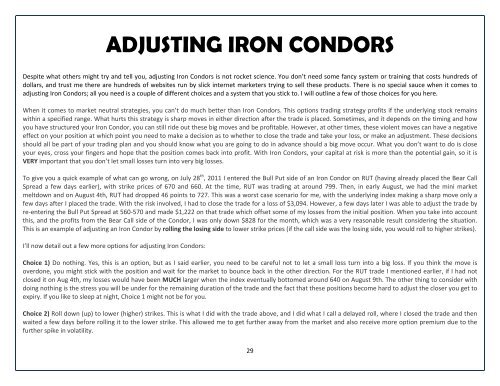Bullshit Free Guide to Iron Condors - Options trading IQ
Bullshit Free Guide to Iron Condors - Options trading IQ
Bullshit Free Guide to Iron Condors - Options trading IQ
You also want an ePaper? Increase the reach of your titles
YUMPU automatically turns print PDFs into web optimized ePapers that Google loves.
ADJUSTING IRON CONDORS<br />
Despite what others might try and tell you, adjusting <strong>Iron</strong> <strong>Condors</strong> is not rocket science. You don’t need some fancy system or training that costs hundreds of<br />
dollars, and trust me there are hundreds of websites run by slick internet marketers trying <strong>to</strong> sell these products. There is no special sauce when it comes <strong>to</strong><br />
adjusting <strong>Iron</strong> <strong>Condors</strong>; all you need is a couple of different choices and a system that you stick <strong>to</strong>. I will outline a few of those choices for you here.<br />
When it comes <strong>to</strong> market neutral strategies, you can’t do much better than <strong>Iron</strong> <strong>Condors</strong>. This options <strong>trading</strong> strategy profits if the underlying s<strong>to</strong>ck remains<br />
within a specified range. What hurts this strategy is sharp moves in either direction after the trade is placed. Sometimes, and it depends on the timing and how<br />
you have structured your <strong>Iron</strong> Condor, you can still ride out these big moves and be profitable. However, at other times, these violent moves can have a negative<br />
effect on your position at which point you need <strong>to</strong> make a decision as <strong>to</strong> whether <strong>to</strong> close the trade and take your loss, or make an adjustment. These decisions<br />
should all be part of your <strong>trading</strong> plan and you should know what you are going <strong>to</strong> do in advance should a big move occur. What you don’t want <strong>to</strong> do is close<br />
your eyes, cross your fingers and hope that the position comes back in<strong>to</strong> profit. With <strong>Iron</strong> <strong>Condors</strong>, your capital at risk is more than the potential gain, so it is<br />
VERY important that you don’t let small losses turn in<strong>to</strong> very big losses.<br />
To give you a quick example of what can go wrong, on July 28 th , 2011 I entered the Bull Put side of an <strong>Iron</strong> Condor on RUT (having already placed the Bear Call<br />
Spread a few days earlier), with strike prices of 670 and 660. At the time, RUT was <strong>trading</strong> at around 799. Then, in early August, we had the mini market<br />
meltdown and on August 4th, RUT had dropped 46 points <strong>to</strong> 727. This was a worst case scenario for me, with the underlying index making a sharp move only a<br />
few days after I placed the trade. With the risk involved, I had <strong>to</strong> close the trade for a loss of $3,094. However, a few days later I was able <strong>to</strong> adjust the trade by<br />
re‐entering the Bull Put Spread at 560‐570 and made $1,222 on that trade which offset some of my losses from the initial position. When you take in<strong>to</strong> account<br />
this, and the profits from the Bear Call side of the Condor, I was only down $828 for the month, which was a very reasonable result considering the situation.<br />
This is an example of adjusting an <strong>Iron</strong> Condor by rolling the losing side <strong>to</strong> lower strike prices (if the call side was the losing side, you would roll <strong>to</strong> higher strikes).<br />
I’ll now detail out a few more options for adjusting <strong>Iron</strong> <strong>Condors</strong>:<br />
Choice 1) Do nothing. Yes, this is an option, but as I said earlier, you need <strong>to</strong> be careful not <strong>to</strong> let a small loss turn in<strong>to</strong> a big loss. If you think the move is<br />
overdone, you might stick with the position and wait for the market <strong>to</strong> bounce back in the other direction. For the RUT trade I mentioned earlier, if I had not<br />
closed it on Aug 4th, my losses would have been MUCH larger when the index eventually bot<strong>to</strong>med around 640 on August 9th. The other thing <strong>to</strong> consider with<br />
doing nothing is the stress you will be under for the remaining duration of the trade and the fact that these positions become hard <strong>to</strong> adjust the closer you get <strong>to</strong><br />
expiry. If you like <strong>to</strong> sleep at night, Choice 1 might not be for you.<br />
Choice 2) Roll down (up) <strong>to</strong> lower (higher) strikes. This is what I did with the trade above, and I did what I call a delayed roll, where I closed the trade and then<br />
waited a few days before rolling it <strong>to</strong> the lower strike. This allowed me <strong>to</strong> get further away from the market and also receive more option premium due <strong>to</strong> the<br />
further spike in volatility.<br />
29


